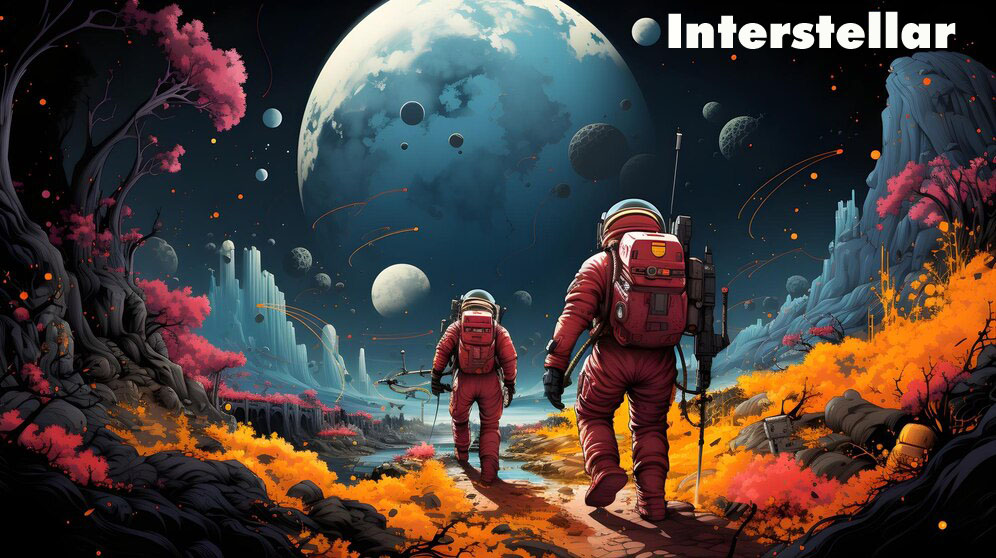Introduction
“Interstellar” is more than just a movie; it’s a cinematic experience that takes audiences on an extraordinary journey through space and time. Directed by Christopher Nolan and released in 2014, the film combines stunning visuals, a gripping narrative, and complex scientific concepts to tell a story of survival and exploration. In this article, we’ll delve into the intricacies of “Interstellar,” exploring its plot, characters, scientific foundations, and its impact on both cinema and popular culture.
Plot Summary
“Interstellar” is set in a dystopian future where Earth is facing ecological collapse. The story follows Cooper (Matthew McConaughey), a former NASA pilot turned farmer, who is recruited for a last-ditch mission to find a new habitable planet for humanity. Alongside a team of scientists, including Dr. Amelia Brand (Anne Hathaway), Cooper travels through a wormhole near Saturn, embarking on a journey that challenges their endurance and understanding of the universe.
Key Characters
Cooper
Cooper is a complex character, driven by a deep sense of duty to his family and humanity. His journey from a reluctant farmer to a pioneering astronaut is both emotional and inspiring.
Murphy (Murph) Cooper
Murphy, Cooper’s daughter, plays a crucial role in the narrative. Her intelligence and determination lead to significant scientific breakthroughs that become pivotal to the story’s resolution.
Dr. Amelia Brand
Amelia Brand is a dedicated scientist whose relationship with her father, Professor Brand (Michael Caine), adds another layer of depth to the plot. Her expertise and bravery are vital to the mission’s success.
TARS and CASE
These robotic assistants provide both comic relief and crucial support during the mission. Their unique personalities and loyalty to the crew make them memorable characters.
Scientific Concepts
Wormholes
A wormhole serves as the central plot device in “Interstellar,” enabling the characters to traverse vast distances in space. The depiction of wormholes is grounded in theoretical physics, drawing on the work of physicist Kip Thorne, who served as a scientific consultant for the film.
Relativity and Time Dilation
The film explores the effects of relativity, particularly how time can flow differently depending on one’s proximity to a massive object like a black hole. This concept is vividly illustrated in the scenes on the water planet, where one hour equals seven years on Earth.
Black Holes and Singularities
The depiction of the black hole, Gargantua, is one of the most visually stunning and scientifically accurate representations in cinema. The film portrays the gravitational pull and the event horizon with meticulous detail.
Visual and Special Effects
“Interstellar” is renowned for its groundbreaking visual effects. The depiction of space travel, alien worlds, and the black hole Gargantua is both visually stunning and scientifically informed. The use of practical effects, combined with CGI, creates an immersive experience that captivates the audience.
Soundtrack and Score
Hans Zimmer’s score for “Interstellar” is iconic, enhancing the emotional and dramatic depth of the film. The use of a pipe organ creates a hauntingly beautiful soundscape that complements the vastness of space and the intensity of the characters’ journey.
Themes and Motifs
Love and Sacrifice
“Interstellar” explores the power of love as a driving force. Cooper’s love for his daughter Murph motivates him to endure the mission’s hardships. The film suggests that love can transcend time and space, influencing decisions and outcomes in profound ways.
Human Survival and Exploration
The film delves into humanity’s instinct to survive and explore. It raises questions about the lengths we are willing to go to ensure the survival of our species and the importance of exploration in finding new frontiers.
Faith vs. Science
“Interstellar” balances themes of faith and science. The characters must trust in their scientific knowledge while also taking leaps of faith in their quest for survival. This interplay adds a philosophical dimension to the narrative.
Cultural and Cinematic Impact
“Interstellar” has had a significant impact on both popular culture and the film industry. Its ambitious storytelling and scientific accuracy have sparked discussions about space exploration, theoretical physics, and the future of humanity. The film’s success has also solidified Christopher Nolan’s reputation as a visionary director.
Critical Reception
“Interstellar” received widespread acclaim from critics and audiences alike. It was praised for its visual effects, direction, performances, and scientific depth. While some found the plot complex, many appreciated the film’s ambition and emotional resonance.
Box Office Success
The film was a commercial success, grossing over $677 million worldwide. Its success at the box office, coupled with positive reviews, underscored its impact as a major cinematic event.
Awards and Nominations
“Interstellar” garnered numerous awards and nominations, particularly for its visual effects, score, and sound design. It won the Academy Award for Best Visual Effects and received nominations in several other technical categories.
Future of Space Exploration in Cinema
“Interstellar” has paved the way for future films about space exploration. Its blend of scientific accuracy and compelling storytelling sets a high standard for the genre. As technology advances, we can expect even more immersive and thought-provoking space films in the future.
Conclusion
“Interstellar” is a masterpiece that combines science fiction with deep human emotions. It challenges audiences to think about the future of humanity, the nature of love, and the mysteries of the universe. Through its compelling characters, stunning visuals, and intricate plot, “Interstellar” has secured its place as one of the most influential films of the 21st century.
FAQs
- Is “Interstellar” scientifically accurate?
Yes, many aspects of “Interstellar” are grounded in real scientific theories, particularly those related to black holes and relativity, thanks to the guidance of physicist Kip Thorne.
- What inspired Christopher Nolan to make “Interstellar”?
Nolan was inspired by the idea of exploring space and the future of humanity. The script, originally written by Jonathan Nolan, was influenced by theoretical physics and the works of scientists like Carl Sagan.
- How does time dilation work in “Interstellar”?
Time dilation in “Interstellar” occurs because the characters are near a massive black hole, which causes time to move slower for them compared to those further away, such as on Earth.
- What is the significance of the bookshelf scene?
The bookshelf scene represents a tesseract, a four-dimensional space created by advanced beings. Cooper communicates with his daughter, Murph, across time and space, providing the key to saving humanity.
- Will there be a sequel to “Interstellar”?
As of now, there are no official plans for a sequel to “Interstellar.” The film is designed to be a standalone story, though its themes and impact continue to inspire discussions and theories.











